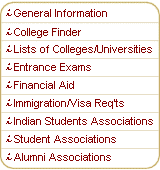|
|
Immigration and Visa Requirements for the USA
Helpful Tips for US Visas
Foreign Students
The Immigration and Nationality Act provides two nonimmigrant visa categories for persons wishing to study in the United States.
The "F" visa is for academic studies, and the "M" visa is for nonacademic or vocational studies.
Changes in U.S. immigration law, effective November 30, 1996, require that no alien (alien refers to a non-citizen) may be issued an F-1 visa to attend a U.S. public elementary or middle school (K-8). Any alien who wishes to attend public high school (grades 9-12) in the United States in student visa (F-1) status must submit evidence that the local school district has been reimbursed in advance for the unsubsidized per capita cost of the education. Also, attendance at U.S. public high schools cannot exceed a total of 12 months. Please note that these changes do not affect other visa categories such as the J-1 exchange visitor program or the qualified school-age child of an alien who holds another type of nonimmigrant visa (i.e., A, E, H, I, L, etc.).
No alien may be issued an F-1 visa in order to attend a publicly-funded adult education program.
Scholastic Preparation
The student visa applicant must have successfully completed a course of study normally required for enrollment.
The student, unless coming to participate exclusively in an English language examination program, must either be sufficiently
proficient in English to pursue the intended course of study, or the school must have made special arrangements for English
language courses or teach the course in the student's native language.
See iMahal resources for further information on English language proficiency tests TOEFL, GRE etc.
Financial Resources
Applicants must also prove that sufficient funds are or will be available from an identified and reliable financial source to defray
all living and school expenses during the entire period of anticipated study in the United States. Specifically, applicants must
prove they have enough readily available funds to meet all expenses for the first year of study, and that adequate funds will be available for each subsequent year of study. The M-1 student visa applicants must have evidence that sufficient funds are immediately available to pay all tuition and living costs for the entire period of intended stay.
See iMahal resources for information on financial assistance and resources
for students in USA.
Acceptance Form
An applicant coming to the United States to study must be accepted for a full course of study by an educational institution approved by the Immigration and Naturalization Service (INS). The institution must send to the applicant a Form I-20A-B, Certificate of Eligibility for Nonimmigrant (F-1) Student Status for Academic and Language Students. The nonacademic or vocational institution must send to the student a Form I-20M-N, Certificate of Eligibility for Nonimmigrant (M-1) Student Status For Vocational Students. Educational institutions obtain Forms I-20A-B and I-20M-N from the INS.
Applying for a Student Visa
Applicants for student visas should generally apply at the U.S. Embassy or Consulate with jurisdiction over their place of permanent residence. Although visa applicants may apply at any U.S. consular office abroad, it may be more difficult to qualify for the visa outside the country of permanent residence.
Required Documentation
Each applicant for a student visa must pay a nonrefundable US$45 application fee and submit:
- An application Form OF-156, completed and signed. Blank forms are available without charge at all U.S. consular offices;
- A passport valid for travel to the United States and with a validity date at least six months beyond the applicant's intended period of stay in the United States. If more than one person is included in the passport, each person desiring a visa must make an application;
- One photograph 1 and 1/2 inches square (37x37mm) for each applicant, showing full face, without head covering, against a light background; and
- For the "F" applicant, a Form I-20A-B. For the "M" applicant, a Form I-20M-N.
- Evidence of sufficient funds.
Other Documentation
Student visa applicants must establish to the satisfaction of the consular officer that they have binding ties to a residence in a foreign country which they have no intention of abandoning, and that they will depart the United States when they have completed their studies. It is impossible to specify the exact form the evidence should take since applicants' circumstances vary greatly.
US Port of Entry
Applicants should be aware that a visa does not guarantee entry into the United States. The INS has authority to deny admission. Also, the period for which the bearer of a student visa is authorized to remain in the United States is determined by the INS, not the consular officer. At the port of entry, an INS official validates Form I-94, Record of Arrival-Departure, which notes the length of stay permitted.
Additional Information
- Employment:
An F-1 student may not accept off-campus employment at any time during the first year of study; however, the INS may grant permission to accept off-campus employment after one year. F-1 students may accept on-campus employment from the school without INS permission. Except for temporary employment for practical training, an M-1 student may not accept employment.
- Family Members : A spouse and unmarried, minor children may also be classified for a nonimmigrant visa to accompany or follow the student. Family members must meet all visa eligibility requirements, including evidence that they will have sufficient funds for their support, and that they will depart the U.S. when the student's program ends. Spouses and children of students may not accept employment at any time.
Further Inquiries
Questions on how to obtain Forms I-20A-B and I-20M-N should be made to the educational institution. If the institution does not have the forms, it needs to contact the local INS office. Questions on visa application procedures at the American consular offices abroad should be addressed to that consular office by the applicant.
How Do I Become an Academic Student in the United States?
Who is Allowed to Study in the United States?
A nonimmigrant is someone admitted
to the U.S. temporarily for a specific purpose. People who are
coming to the United States to pursue full-time academic or vocational
studies are usually admitted in one of two nonimmigrant categories.
The F-1 category includes academic students in colleges, universities,
seminaries, conservatories, academic high schools, other academic
institutions, and in language training. The M-1 category includes
vocational students. For more information on vocational studies
in the United States, please see How Do
I Get Approval For Vocational Studies in the United States?.
If you are planning to study in the United States as an Exchange
Visitor, please see the
United States Information Agency and the
Department of State
websites.
Please note: If you wish to attend public high school (grades
9-12) in the United States in student (F-1) status, you must submit
evidence that the local school district has been reimbursed in
advance for the unsubsidized per capita cost of the education.
Also, attendance at U.S. public high schools cannot exceed a total
of 12 months. F-1 students are prohibited from attending public
elementary schools and publicly-funded adult education programs
in the United States.
What Does the Law Say?
The Immigration and Nationality Act (INA) governs the
admission of all people to the United States. For the part of
the law concerning temporary admissions to the United States,
please see INA
§ 214: Admission of Nonimmigrant. The specific eligibility requirements and
procedures for applying for academic student status are included
in the Code of Federal Regulations [CFR] at
8CFR § 214.2(f): Students in colleges, universities, seminaries, conservatories, academic high schools, elementary schools, other
academic institutions, and in language training programs.
How Do I Apply?
-
How Do I Apply if I am Outside of the United States?
You first must apply to study at an INS-approved school
in the United States. When you contact a school that you are interested
in attending, you should be told immediately if the school accepts
foreign national students. If you are accepted, the school should
give you INS Form I-20 A-B/ID (Certificate of Eligibility for
Nonimmigrant (F-1) Student Status - for Academic and Language
Students). If you require a visa, then you should take the INS
Form I-20 to the nearest U.S. consulate to obtain a student visa.
Only bring the INS Form I-20 from the school you plan on attending
for visa processing at the U.S. consulate. You must also prove
to the consulate that you have the financial resources required
for your education and stay in the United States. Please see the
State
Department Website for more information on visa processing.
When you arrive in the United States, you should receive an INS
Form I-94 (Arrival-Departure Record) that will include your admission
number to the United States. An INS inspector will write this
admission number on your INS Form I-20 A-B/ ID. The INS inspector
will then send pages one and two of this form, known as I-20 A-B,
to your school as a record of your legal admission to the United
States. You are expected to keep pages three and four, known as
the I-20 ID. This document is your proof that you are allowed
to study in the United States as an F-1 student. You should see
your designated school official (DSO) if you need a replacement
copy of your I-20 ID. You should also keep safe your INS Form
I-94, because it proves that you legally entered the United States.
If you need a replacement copy of your INS Form I-94, please see
How Do I Get an Arrival-Departure Record?.
How Can I Change My Nonimmigrant Status to Become
a Student If I Am Already in the United States?
You first must apply to study at an INS-approved school in
the United States. When you contact a school that you are interested
in attending, you should be told immediately if the school accepts
foreign national students. If you are accepted, the school should
send you INS Form I-20 A-B/IID (Certificate of Eligibility for
Nonimmigrant (F-1) Student Status - for Academic and Language
Students). You must submit this form and an
INS Form I-539 (Application to Extend/Change Nonimmigrant Status)
to the INS. You must also prove that you have the financial resources
required for your education and stay in the United States. For
more information, please see How Do I Get
Permission to Change to a New Nonimmigrant Status?.
How Do I Apply for Permission to Transfer Schools?
You must be a full time student in good academic standing.
You must notify your current school of your intent to transfer.
You must ask the school that you plan on attending to give you
a new INS Form I-20 A-B/ID (Certificate of Eligibility for Nonimmigrant
(F-1) Student Status - for Academic and Language Students). You
must complete your portion of the INS Form I-20 and give it to
your new designated school official (DSO) within 15 days of transferring.
The designated school official (DSO) should give you the last
two pages, known as Form I-20 ID, and forward a copy of the first
two pages, known as Form I-20 A-B, to the INS and your prior school.
Can I Bring My Spouse and Children with Me to the
United States?
Your spouse and children may come with you
to the United States in F-2 status. They should go with you to
the U.S. embassy or consulate when you apply for your student
(F-1) visa. They should be prepared to prove their relationship
to you. If your spouse or children are following to join you at
a later date, they should provide the U.S. embassy staff with
a copy of you INS Form I-20 ID (Certificate of Eligibility for
Nonimmigrant (F-1) Student Status - for Academic and Language
Students) and proof of their relationship to you. The F-2 status
of your family will be dependent upon your status as the F-1 academic
student. This means that if you change your status, your family
must change their status. If you lose your status, your family
will also lose their status. (For more information on changing
status, please see How Do I Get Permission
to Change to a New Nonimmigrant Status?)
How Long Can I Stay in the United States?
You are allowed to stay in the United States for as long
as you are enrolled as a full-time student in an educational program
and making normal progress toward completing your course of study.
If approved, you also will be allowed to stay in the country up
to twelve additional months beyond the completion of your studies
to pursue practical training. At the end of your studies or practical
training, you will be given sixty days to prepare to leave the
country. See
8 CFR § 214.2: (Special requirements for admission, extension, and maintenance of status.) for more complete time limits.
How Can I Extend My Stay as a Student in the United States?
You do not need to apply to extend your stay in the United
States as long as you are maintaining your student status and
making normal progress toward completing your academic course
of study. The designated school official (DSO) from your school
will write down a completion date on your INS Form I-20 A-B (Certificate
of Eligibility for Nonimmigrant (F-1) Student Status - for Academic
and Language Students). Under normal circumstances, you should
be able to complete your studies by this date. If you need to
extend your stay for compelling academic or medical reasons, then
you and the designated school official (DSO) should fill out INS
Form I-538(Certification By Designated School Official)
and send it to the INS student data center at least 30 days before
the completion date listed on INS Form I-20 A-B.
Will I Get a Work Permit?
You may be allowed to work on-campus or off-campus (after
the completion of your first year of study) under limited circumstances.
Please see the rules on student employment at
8 CFR 214.2 (f) . This
document specifically deals with the issue pertaining to "Students in colleges, universities, seminaries, conservatories, academic high schools, elementary schools, other
academic institutions, and in language training programs."
You may also wish to discuss employment with the
designated school official (DSO) at your school. Your accompanying
spouse and child may not accept employment.
Can I Travel Outside the United States?
Students may leave the United States and be readmitted
after absences of five months or less. Upon your return to the
United States, you should provide immigration inspectors with:
- A valid passport.
- A valid F-1 entry visa stamped in the passport (if necessary). <\li>
- A current INS Form I-20 ID (Certificate of Eligibility for Nonimmigrant
(F-1) Student Status - for Academic and Language Students) signed
by your appropriate school official (you should have the appropriate
school official sign your INS Form I-20 each time you wish to
temporarily travel outside the United States). <\li>
- A new INS Form I-20 A-B/I-20 ID if there have been any substantive
changes in your course of study or place of study. <\li>
- Proof of your financial support. <\li>
When making your travel plans, please remember that you must be
a full-time student to keep your F-1 student status. You will
be considered to be "in status" if you take the annual
summer vacation, as long as you are eligible and intend to register
for the next school term.
How Can I Get INS Forms?
Your should be able to pick up immigration-related forms
from your designated school official (DSO). Only your designated
school official (DSO) can give you an INS Form I-20 (Certificate
of Eligibility for Nonimmigrant (F-1) Student Status - for Academic
and Language Students) or an INS Form I-538 (Certification By
Designated School Official). If you would like other immigration
forms, you may call 1-800-870-3676, or submit a request through
our forms by mail system. For further information on filing fees,
please see INS filing fees,
fee waiver request procedures, and
the INS fee waiver policy memo .
Can Anyone Help Me?
Your school will have a designated school official (DSO)
to help you with immigration issues. Please note that you (the
F-1 student) are solely responsible for following U.S. immigration
laws.

|
 |





